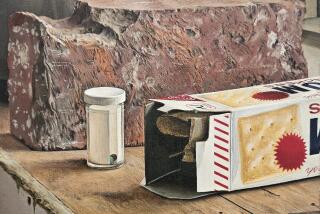Book review: Joyceâs jigsaw masterpiece
Often started, seldom finished. Thatâs the knock on James Joyceâs âUlysses.â Everyone knows Buck Mulligan is âstatelyâ and âplump,â but by the time Stephen Dedalusâ allusive stream of consciousness gives way to Leopold Bloomâs humanist point of view in the fourth chapter, many readers have given up. Too long. Too wordy. Too confusing.
However, for those who have tried to read âUlyssesâ but were unable to finish (or thought about it and said they did), two new books offer something of a corrective.
In âThe House of Ulysses,â translated by Nick Caistor (Dalkey Archive: 280 pp., $14.95 paper), Spanish novelist JuliĂĄn RĂos offers a guide that endeavors to entertain rather than educate. In an interview published in the literary magazine Context, he describes âThe House of Ulyssesâ as âa fiction-essay or kind of meta-novel.â
RĂosâ main character, referred to as the Cicerone, a guide, leads a group of visitors through the bookâs 18 chambers, one for each chapter of âUlysses.â Dressed âin rigorous black with a purple polka-dot bow-tie, long-legged and pallid, white streaks in chestnut hair smoothed back with brilliantine, a blind manâs glasses, a straggly mustache,â the Cicerone is a stand-in for Joyce himself: part carnival barker, part scholar.
Other characters include the portly professor Ludwig Jones, an âOrsonwellian Falstaff about to burst the seams of his lizard-green tweed suitâ and a man with a Macintosh computer, a play on one of âUlyssesâ â most enduring mysteries â a character who shows up in various scenes and is identified only as âthe man in the Macintosh.â The group is rounded out by a trio of readers: a mature fellow named Ananias, a young woman named Babel or Belle with âlaughing black eyesâ who affects a âUlysses Museumâ T-shirt, and a fusty old Critic. RĂosâ readers may recognize these characters from his postmodernist mega-work, âLarva: A Mid-Summer Nightâs Babel.â But in âThe House of Ulysses,â the readers are addressed simply as A, B and C.
A typical âroomâ includes a brief summary of the corresponding chapter in âUlyssesâ by the Cicerone, some scholarship from the Professor, the schema that Joyce provided early critics courtesy of the man with the Macintosh, and some playful punning from the troika of readers. Then the Cicerone proceeds through âpassagewaysâ that consist of short, discursive reflections on various aspects of the novel.
âThe House of Ulysses,â though rigidly structured, has no plot. The characters, such as they are, serve as devices to animate an extended conversation about the book in a way that captures the spirit of Joyceâs jouissance, introduces the reader to rudimentary background information necessary for deciphering the novel (Homerâs âOdyssey,â for instance, or Shakespeareâs âHamletâ) and engages in considerable wordplay. Hereâs an early exchange regarding Stephen Dedalus in Chapter 3, the point where many readers move on:
Professor Jones was close to roaring. Whatâs in a name? LEOpold is feline, just as Stephen is canine. âDogsbody,â Mulligan calls him.
It also means servile, said C.
A vile sir? asked B.
Vile is evil as dog is God. The body of God: Godsbody? asked A.
The result is a work of criticism, albeit in disguise, that succeeds in making âUlyssesâ immediate to readers familiar with the book and accessible to those reading it for the first time. âIt is an easy house to run,â RĂos writes, and a fun house too, and I strongly recommend it to those unable to finish âUlysses.â
If Ulysses is a house, claims Declan Kiberd, itâs one thatâs been overrun by academics of a highly specialized nature, analyzing every word until theyâve lost sight of the big picture. In other words, the critics have overstayed their welcome, a point Kiberd makes again and again in ââUlyssesâ and Us: The Art of Everyday Life in Joyceâs Masterpieceâ (W.W. Norton: 416 pp., $17.95 paper).
As a professor of Anglo-Irish literature at University College, Dublin, the question of accessibility is of tantamount importance to Kiberd. He aims to demystify the aura of impenetrability surrounding the novel by demonstrating how âJoyceâs project was indeed to rejoin the sacred to the everyday.â
According to Kiberd, Stephen Dedalus is an example of how not to live: a petty, unwashed narcissist who looks down at others even while he gets drunk and starts a brouhaha in a brothel. Bloom, though Jewish, âis more Christlike than any of his fellow citizens, being constantly willing to put himself in the other fellowâs position.â He, not Stephen, provides an example of how to live in a world whose inhabitants are continually at war with one another.
If RĂos adopts the tone of a gaggle of over-caffeinated graduate students, Kiberdâs book reads like a series of lectures from a wise and learned professor. Though the authors are very different, the books have much in common. Ultimately they share the same goal: to include more readers in the conversation about one of the most rewarding novels ever written.
Perhaps William Faulknerâs counsel is best: âYou should approach Joyce as a preacher approaches the Old Testament â with faith.â
Ruland is the author of the short-story collection âBig Lonesome.â
More to Read
The biggest entertainment stories
Get our big stories about Hollywood, film, television, music, arts, culture and more right in your inbox as soon as they publish.
You may occasionally receive promotional content from the Los Angeles Times.










